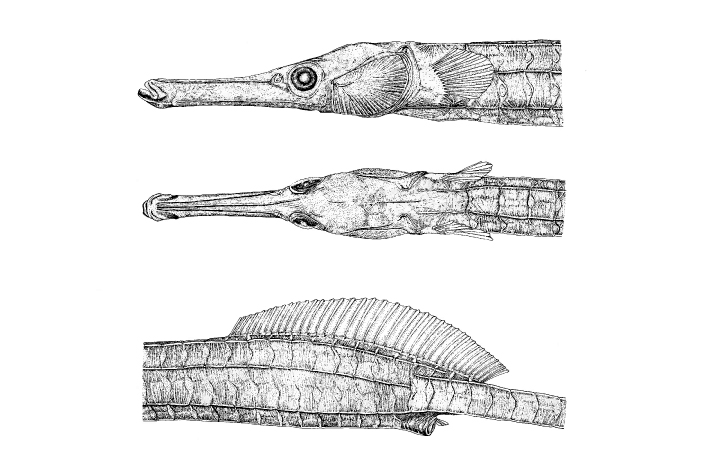Tucker's Pipefish, Mitotichthys tuckeri (Scott 1942)

Illustration of the head, anterior trunk rings and lateral section of body showing the configuration of the rings, ridges & fin positions of an adult female Tucker's Pipefish, Mitotichthys tuckeri. Source: Fig 10, in Dawson (1984) Mem. Mus. Vict 45: 102. License: Public Domain
Tucker’s Pipefish is endemic to New South Wales and northern Tasmania where it lives in kelp beds and amongst floating Sargassum algae.
Tucker's Pipefish, Mitotichthys tuckeri (Scott 1942)
More Info
|
Distribution |
Endemic to temperate waters of southern Australia, from Twofold Bay, New South Wales and Bridport, northern Tasmania; inhabits kelp beds and floating Sargassum along the open coast at 9–18 m, and is occasionally wahsed ashore during storms. |
|
Features |
Meristics: D 35–38; A 2; P 10–12; C 10; trunk rings 21–23; tail rings 39–42; subdorsal rings 10.0–7.5 + 1.5–3.25 = 10.0–12.75. Head and body: Body elongated, trunk moderately shallow, somewhat deeper in adult females than adult males, upper profile slightly convex near dorsal-fin base; head aligned with body; snout long, 47–56% HL; snout depth 14–22% snout length; median dorsal snout ridge low, entire; opercle without distinct longitudinal ridge in subadults and adults; superior trunk and tail ridges discontinuous; lateral trunk ridge straight, ends near anal ring; inferior trunk and tail ridges continuous; principle body ridges entire, low on trunk, a little elevated on distal half or more of tail; body behind dorsal fin 60–103% longer than before dorsal fin; scutella not keeled; without dermal flaps; tail not prehensile. Fins: Dorsal fin origin on trunk, closer to tip of snout than to tip of tail, base of moderate length; pectoral fin base without distinct ridges; anal fin tiny, below front half of dorsal fin; caudal fin very small. |
|
Size |
To 190 mm SL. |
|
Colour |
Overall tan, dorsal surface darker with additional irregular dark marks, underside pale. |
|
Feeding |
Not reported – likely to feed on small crustaceans. |
|
Biology |
Reproduction: Ovoviviparous (gives birth to live young) with eggs brooded by males in an enclosed brood pouch under tail just behind the anal fin; pouch plates vestigial or absent, pouch folds present with everted pouch closure; males brooding at about 120 mm SL. Eggs: Egg diameter is about 1.2mm; brood pouches reportedly contained about 100 eggs in 3-6 transverse rows. Larvae: Not described. |
|
Fisheries |
Of no interest to fisheries or aquaculture. |
|
Conservation |
CITES: not listed. IUCN Red List Status: not evaluated. Australian Commonwealth legislation: Marine listed under the Environment Protection and Biodiversity Conservation Act 1999 (EPBC Act). State Legislation: Listed as protected under the New South Wales and Tasmanian Fisheries Management Acts. |
|
Remarks |
This poorly known species lives in coastal areas rarely visited by divers or trawlers. |
|
Similar Species |
Differs from M. mollisoni and M. semistriatus in having 7.5-10 subdorsal trunk rings (vs 2.75-4.25) and 39-42 tail rings (vs 46-50). |
|
Etymology |
Mitotichthys from the Greek mitis -e (soft), ous, otis (ear) and ichthys (fish). The species is named for Mr Tucker. |
|
Species Citation |
Syngnathus tuckeri Scott 1942, Rec. Queen Vic. Mus. Launc. 1(1): 17, pl. 5, Bridport, northern Tasmania. |
|
Author |
Dianne J. Bray & Vanessa thompson |
Tucker's Pipefish, Mitotichthys tuckeri (Scott 1942)
References
Dawson, C.E. 1978. Description of a new western Australian pipefish (Choeroichthys latispinosus), with notes on Syngnathus tuckeri Scott and Nannocampichthys Hora and Mukerji. Rec. West. Aust. Mus. 6(4): 413-421.
Dawson, C.E. 1984. Synopsis of Australian pipefishes usually referred to the syngnathine (tail-pouch) genera Syngnathus, Leptonotus and Histiogamphelus. Mem. Mus. Vic. 45: 71-123, Pls. 1-9.
Dawson, C.E. 1985. Indo-Pacific Pipefishes (Red Sea to the Americas). Gulf Coast Research Laboratory, Ocean Springs, Mississippi. 230 pp.
Kuiter, R.H. 2008. Family Syngnathidae (pp. 448–479). In Gomon, M.F., D.J. Bray & R.H. Kuiter. (Eds.) Fishes of Australia's Southern Coast. New Holland Press & Museum Victoria, Melbourne, Australia, 928 pp.
Kuiter, R.H. 2009. Seahorses and their relatives. Aquatic Photographics, Seaford, Australia. Pp. 1–333.
Last, P.R., Scott, E.O.G. & Talbot, F.H. 1983. Fishes of Tasmania. Tasmanian Fisheries Development Authority, Hobart. 563pp.
Paxton, J.R., J.E. Gates, D.F. Hoese & D.J. Bray. 2006. Syngnathidae (Pp. 810–846). In Beesley, P.L. & Wells, A. (Eds) Zoological Catalogue of Australia. Volume 35. Fishes. ABRS & CSIRO Publishing, Australia., 3 vols.
Pogonoski, J.J., D.A. Pollard & J.R. Paxton. 2002. Conservation Overview and Action Plan for Australian Threatened and Potentially Threatened Marine and Estuarine Fishes, Environment Australia, Canberra. 375 pp.
Scott, E.O.G. 1942. Syngnathus tuckeri sp. nov.: a new Tasmanian Pipefish. Rec. Queen Vic. Mus. Launc. 1(1): 17-20.
